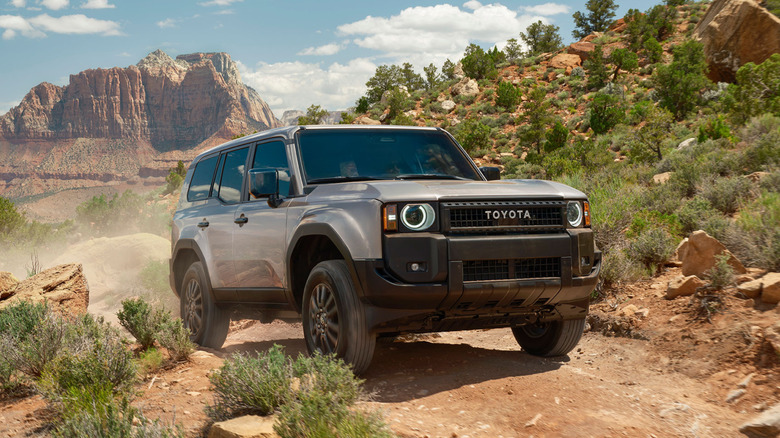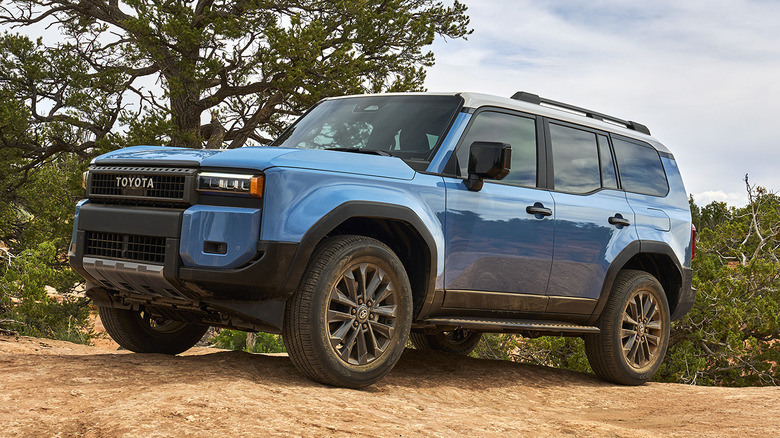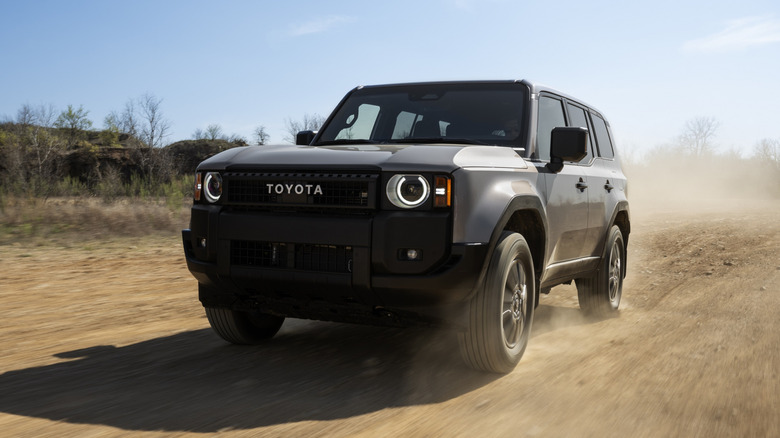Toyota Land Cruiser 1958: How Does It Compare To The Standard Trim Model?
The Land Cruiser 1958 is the base trim level for the rough-and-tumble Toyota off-roader. It has an MSRP of $58,150 (including $1,450 destination fee) compared to the "standard" Land Cruiser model, which checks in at $62,920. So, what do you get for that extra money? Or, more accurately, what is the 1958 model missing that the standard Land Cruiser gets?
In the Land Cruiser 1958, things are a bit bare bones, but that's how some owners might prefer their off-roaders: the less tech, the better. After all, the 1958 is a trim level meant to pay homage to the past; 1958 was the year that the Land Cruiser was introduced to the United States, and SUVs back then were definitely less luxurious. On the outside, the 1958 has circular headlights instead of the rectangular ones that come with the upper trim. Fog lights are standard, but not the upgraded Rigid units. The rear tailgate is opened physically, rather than by a power-operated mechanism.
The 1958 model also gets unique 18-inch alloy wheels wrapped in 245/70R18 tires, while the standard Land Cruiser gets different wheels and wider 265/70/R18 tires. Roof rails and all-weather floor mats are standard on the upper trim level but are unavailable on the 1958. Color schemes are pretty limited, too. The 1958 can only be had in Black, Ice Cap (white), or Meteor Shower (silver) for 2025, while the standard Land Cruiser gets eight different exterior colors to choose from.
Less tech and fewer creature comforts
There's a bigger difference between the Land Cruiser 1958 and the standard trim when it comes to tech and interior equipment. The 1958 has an 8-inch touchscreen display, a six-speaker stereo, and wireless Apple CarPlay and Android Auto. The upper Land Cruiser trim maintains the smartphone connectivity, but it adds a much larger 12.3-inch touchscreen display along with a 10-speaker stereo. A 14-speaker JBL stereo is also available here. The upper trim also comes standard with Toyota's Multi-Terrain Monitor (MTM), which will help you navigate tough off-road terrain.
The Land Cruiser 1958's steering tilts and telescopes, but it's a manual adjustment. The standard Land Cruiser gets power adjustability. The 1958 has heated front seats with cloth upholstery and manual adjustments for the driver and passenger, but the standard Land Cruiser adds a ventilation function to the front seats along with a power-adjustable driver's seat. Available options for the Land Cruiser that you can't get on the 1958 trim include 20-inch wheels, a head-up display for the driver, a cooler for the center console, a power sunroof, wireless smartphone charging, and leather upholstery. Driver aids like lane-keep assist, front cross-traffic alert, and traffic jam assistant are also exclusive to the standard Land Cruiser.
The same power, efficiency, and off-road capabilities
With the Land Cruiser First Edition now discontinued, these two versions of the SUV are the only available. When it comes to hardware and underpinnings, there isn't too much to speak of that separates the Land Cruiser trim levels. Both versions of the Land Cruiser get Toyota's i-Force Max hybrid powertrain — one that's becoming more ubiquitous across the automaker's lineup, present in trucks and SUVs like the Toyota Tacoma and Toyota 4Runner. Under the hood of the Land Cruiser, the turbocharged 2.4-liter engine produces 326 horsepower and 465 lb-ft of torque. It's paired with an 8-speed automatic transmission, and all Land Cruisers get four-wheel drive as standard.
Regardless of which Land Cruiser trim you go with, fuel economy estimates are the same. The EPA estimates that the Land Cruiser will return 23 mpg combined (22 city/25 highway). That might not seem like impressive fuel economy, but it's much better than the Land Cruiser generation that came before it, which had a 5.7-liter V8 that returned just 14 mpg combined (13 city/17 highway). It's worth noting, though, that the i-Force Max powertrain requires 91-octane fuel — so gas won't be cheap. Both versions of the SUV have the same approach, departure, and break-over angles, along with 8.7 inches of ground clearance, so off-roading won't change much between the two. Both also have the same maximum towing capacity of 6,000 pounds.


